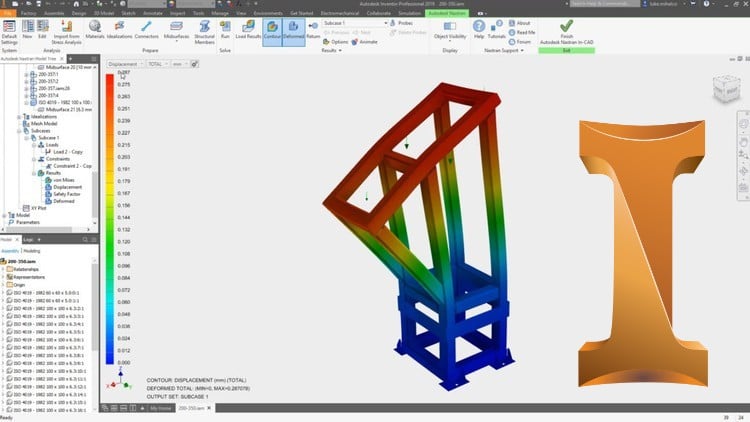Inventor Nastran - Mechanical simulation - AulaGEO
- Description
- Curriculum
- FAQ
- Reviews

Autodesk Inventor Nastran is a powerful and robust numerical simulation program for engineering problems. Nastran is a solution engine for the finite element method, well recognized in structural mechanics. And there is no need to mention the great power that Inventor gives us for mechanical design.
Inventor Nastran unites the best of these two software giving us the power to solve complex simulation problems within Inventor’s comfortable environment.
During this course you will learn the typical workflow for the design and simulation of mechanical parts. We will always give a simple and compressible introduction to the theoretical aspects of simulation. This way you can develop criteria and understand the reasons for the parameters that you will find in the program.
We will go from the simplest to the most complex, starting with elastic and linear analyzes of mechanical parts. After overcoming the basic concepts, we will enter the world of nonlinear analysis, where many practical problems must be solved. Next, we will move on to dynamic analysis, where we will discuss various types of studies used in practice, including fatigue analysis. And lastly, we will look at coupled heat transfer studies.
It is a very complete course that will lay the foundations and allow us to build on them.
#AulaGEO
The AulaGeo team worked hard on this course. It was developed in Spanish by Enzo, voiced by Gabriella for English speaking students.
-
5Idealizations
-
6Exercise - Cantilever Beam
-
7Cantilever beam verification
-
8User interface
-
9Exercise - Cast Lever
-
10Exercise - Modifying edge conditions
-
11Mesh
-
12Mesh settings
-
13Meshing and convergence
-
14Exercise - Refine the mesh
-
15Model contacts
-
16Exercise - Adding contacts and symmetry
-
17Analysis settings
-
18Viewing results
-
19Compare iterations
-
20Uniqueness of tensions
-
21Linear and nonlinear analysis
-
22Geometric nonlinearity
-
23Material non-linearity
-
24Nonlinearity of edge conditions
-
25Nonlinearity by element type
-
26General rules for nonlinear analysis
-
27Exercise - Flat walled tank
-
28Exercise - Snap-through-back
-
29Nonlinear transient analysis
-
30Preparation for impact analysis
-
31Exercise - Ball Impact
-
32Exercise - AIA (Automatic Impact Analysis)
-
33Nonlinear materials
-
34Exercise - Flex Test






Social Network